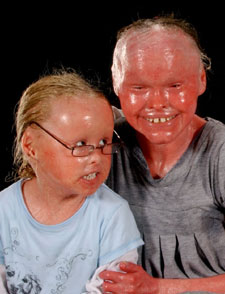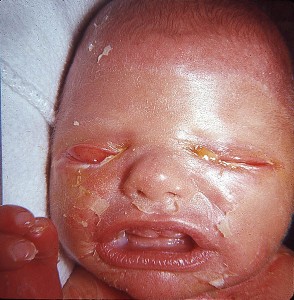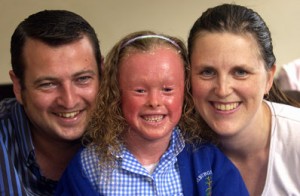Harlequin Ichthyosis is a rare disease that gives rise to life-threatening conditions in sufferers. Read on to know about the causes, symptoms and treatment of this condition. There are also some Harlequin Ichthyosis photos that you may use for reference.
What is Harlequin Ichthyosis?
Page Contents
It is an acute hereditary disorder of the skin that is characterized by excessive production of keratin and consequent hardening of the skin.
Approximately 100 people around the world are said to suffer from this disease at any given period. The exact incidence of this disorder is unknown.
The disease is also known by other names like Itcthyosis Fetalis, Keratosis Diffusa Fetalis and Itchyosis Congenita. Babies with this disorder are also known as “Harlequin babies”.
History of Harlequin Ichthyosis
This is a rare disease that has been reported since the 18th century. In the later part of the early decade of twentieth century, individuals suffering from this condition rarely survived beyond first week as a result of associated complications.
Picture 1 – Harlequin Ichthyosis
Source – 4.bp.blogspot.com
Harlequin Ichthyosis Symptoms
This condition gives rise to acute deformities in the face and the cranium (braincase). There may be poor development or complete absence of nose and ears in a Harlequin Ichthyosis baby. The Keratin layer of the skin in infants in fetus may thicken. This leads to the development of large, diamond shaped scales over the skin surface. There is also unusual contraction of the ears, eyes, ears and penis. The motion in affected children becomes extremely limited due to thickening of the keratin compound in skin. The cracks that arise within the scales over the skin surface make it susceptible to infection by bacteria and other microbial agents.
Can Harlequin Ichthyosis Affect Eyes?
In patients with Harlequin Ichthyosis eyelids are severely turned over due to the occurrence of another condition known as Ectropion. It leaves the eyes and the region surrounding them quite vulnerable to infection. There may also be bleeding in these regions on birth.
As aforesaid, this condition can result in dryness of the skin that can pull the lips and fix them into a wide contorted position (eclabium). The fingers, feet and the arms are almost always misshapen in such a manner that it is difficult to bend them properly. Their size may also be lesser than normal. There may be Hypoplasia in the fingers which make it difficult for sufferers to properly grab things or even touch them. In infants with this condition, another disorder known as Polydactyly may also be present. Infants suffering from Polydactyly may suffer from more number of fingers or toes.
Individuals with dry, cracked skin from this disease can be highly susceptible to alterations in temperature. This can prevent normal loss of heat, as in healthy persons. This can lead to Hyperthermia, a condition that is marked by abnormally high body temperature. The respiration in such sufferers may also be impeded by the skin, which stops the chest wall from spreading out and sucking in enough oxygen. This can result in Respiratory Failure and Hypoventilation. Affected individuals often suffer from dehydration as their cracked skin is not suitable to retain water.
Harlequin Ichthyosis Causes
This condition is a result of mutations in the gene named ABCA12 that helps in the manufacturing of a protein that is necessary for the normal maturation of skin cells. The protein is also important for transporting fats (lipids) in the epidermis or the outer skin layer.
Certain mutations in the ABCA12 gene stop the manufacturing of ABCA12 protein in the cells. Other mutations result in the creation of an unusually tiny version of the protein that fails to properly transport lipids. A lack of functional ABCA12 protein breaks up the usual maturation of the epidermis. This leads to thickened, hard scales that strongly indicate the presence of Harlequin Ichthyosis.
This condition only arises when both parents are carriers of the same impaired gene. It is only in one in a million cases that this may occur. However, it is only in one out of 4 cases that a harlequin child may be born to such parents.
Harlequin Ichthyosis Treatment
This disease is mainly cured by the use of the drug known as Isotretinoin (Isotrex). With effective treatment, the dry, scale-like skin will gradually come off as a peel. During this period, an infant may be susceptible to infections. Antibiotic treatment can be required to avoid infection at this period. Using a Retinoid such as Oral Etretinate can help to accelerate the speed of scale shedding. Most infants with this disorder require undivided attention and nursing care for the first few weeks of life.
Harlequin Ichthyosis Fetus
Harlequin fetus is the most acute form of Congenital Ichthyosis that is very rare in nature. It affects only one out of 300.000 births. In this disorder, an Autosomal Recessive form of inheritance is seen. A new dominant autosomal mutation may be responsible. This disease has a very bad prognosis as neonates generally die within the first few hours or days of life. Harlequin Fetus may arise in patients with a father who has a history of Psoriasis.
The earliest report of this disease was made by Oliver Hart in 1750. Since that time, it has been mentioned by various names like:
- Fetal ichthyosis
- Ichthyosis intrauterine
- Keratosis diffusa fetalis
- Congenital diffuse maligna keratoma
- Malignant keratosis
Babies with this disease are known as “Alligator Baby”.
Harlequin Ichthyosis Pictures
Here are some pictures of Harlequin Ichthyosis Syndrome that will give you an idea about the appearance of skin affected by this disease. You may use these Harlequin Ichthyosis images for reference.
Picture 2 – Harlequin Ichthyosis Image
Source – peds.ufl.edu
Picture 3 – Harlequin Ichthyosis Picture
Source – images.icnetwork.co.uk
Harlequin Ichthyosis Survivors
Survival of affected infants was rare in early days in the initial days after birth. With improved treatment and medical support, people with this syndrome have a higher chance of entering into infancy and teenage years.
This disease was extremely life-threatening in the past. Systemic Retinoid Therapy and Intense Supportive Care in the neonatal period have been found to improve the rate of survival. Survival with this disease aims at protecting the body and contending with the development of skin.
Individuals with a dry, scaly skin should spend one to two hours every day soaking in baths. This can make their skin soft. Bathing should be followed by a forceful scrubbing, which can remove the external skin layer. It is also important to use moisturizers and skin creams to keep the skin hydrated. Ryan Gonzalez, a patient with this disorder, is a successful example that it is possible to survive and live actively with this disease. However, it is still only rarely that one gets to see Harlequin Ichthyosis adults. Systemic infection is usually responsible for the death of persons with this disorder a few days after birth.
The only person who has lived for the longest period of time is a 26 year old Nusrit Shaheen who has a good health condition.
References:
http://ghr.nlm.nih.gov/condition/harlequin-ichthyosis
http://emedicine.medscape.com/article/1111503-overview
http://www.firstskinfoundation.org/content.cfm/category_id/741/page_id/547
http://www.mymultiplesclerosis.co.uk/misc/harlequin.html



